
If your dentist has recommended a root canal, there’s no reason to worry. Modern root canal treatment is a precise, comfortable procedure designed to relieve severe tooth pain and to preserve your natural tooth when the inner tissues are inflamed or infected. In many cases, root canal therapy is the best way to stop an infection from spreading and to restore long-term oral function.
At Smiles Dental at Reston Town Center, we combine proven endodontic techniques with patient-centered care to make the process as smooth as possible. Our team focuses on minimizing discomfort, explaining each step clearly, and helping you return to eating, speaking, and smiling with confidence.
A root canal removes damaged or infected pulp—the soft tissue inside a tooth—then cleans, disinfects, and seals the space to prevent reinfection. With modern instruments and materials, the procedure is much less invasive than in the past and usually restores the tooth’s comfort and function without the need for extraction.
Preserving a natural tooth when feasible is important because it maintains chewing efficiency, supports adjacent teeth, and helps preserve jawbone structure. While tooth replacement options exist, keeping your natural tooth avoids the complexity and additional procedures that sometimes follow extraction.
Most patients report significant relief after treatment, and with proper restoration and oral hygiene, a treated tooth can remain healthy for many years. Timely treatment and a suitable final restoration—often a crown—are key to long-term success.

Inside each tooth is a central chamber that contains the dental pulp: connective tissue, blood vessels, and nerves. The pulp supports tooth development and provides sensory feedback. When decay, cracks, or trauma reach this inner area, bacteria can invade and inflame or destroy the tissue.
Symptoms vary depending on the extent of injury or infection. Some people experience sharp, lingering pain or heightened sensitivity to hot and cold. Others might have little pain initially while X-rays reveal issues that need attention. Because symptoms can be inconsistent, a careful clinical exam and imaging play a vital role in diagnosis.
If the pulp cannot heal on its own, removing the diseased tissue and sealing the canals prevents the infection from spreading to surrounding bone and soft tissues. This conservative approach preserves what remains of your natural tooth and supports overall oral health.
Not every ache means a root canal is required, but certain patterns of pain and visual changes are clear signals to seek an evaluation. Early recognition helps avoid more extensive problems and increases the chance of saving the tooth with straightforward treatment.
Below are common signs that suggest pulpal involvement or infection. If you notice one or more of these, contact our office for an assessment.
Pain that lingers, intensifies, or wakes you at night often indicates an internal problem. This isn’t always constant—sometimes it flares with pressure or certain temperatures—but ongoing pain warrants prompt attention.
Brief sensitivity is common, but a sharp or lingering reaction to hot or cold can mean the nerve inside the tooth is compromised. If the sensation doesn’t settle down shortly after removing the stimulus, have it checked.
If biting or slight pressure causes pain, it can indicate inflammation or an abscessed tooth. This type of sensitivity is different from typical chewing soreness and often points to deeper involvement.
A tooth that becomes darker after an injury or over time may have experienced internal tissue damage. Discoloration can be a useful visual clue that the pulp is affected.
Cracked or fractured teeth can expose the pulp to bacteria or trauma. Even a small, unnoticed crack can allow infection to develop below the surface.
Swelling near the tooth, a tender gum area, or a draining lesion (sometimes felt as a pimple-like bump) indicates an active infection. These signs require timely evaluation and treatment.
Infections that affect surrounding bone can reduce support for the tooth, producing mobility. In many cases, root canal therapy halts the process so the area can heal and regain stability.

Delaying care when a tooth is infected or severely inflamed allows the problem to worsen. An untreated dental infection can spread to adjacent teeth and bone, and in some cases lead to more complex procedures. Early intervention typically simplifies treatment and increases the chance of saving the natural tooth.
Routine exams and digital imaging often catch issues before they become painful. Sometimes a tooth with no obvious symptoms will show signs of trouble on an X-ray—this is why regular checkups are an important part of prevention and early treatment.
When a root canal is recommended, scheduling treatment in a timely manner reduces the risk of complications and helps preserve more of the tooth’s remaining structure for a durable restoration.
Root canal therapy is performed with local anesthesia to keep you comfortable. The dentist creates a small opening in the crown of the tooth, removes the inflamed or infected pulp, and shapes the canals so they can be thoroughly cleaned and disinfected. Once the canals are prepared, they are filled with a biocompatible material and sealed to reduce the chance of reinfection.
Depending on the tooth’s complexity and the presence of infection, treatment may be completed in a single visit or over two appointments. If a temporary filling is placed, a permanent restoration—commonly a crown—will be recommended to restore strength and protect the tooth from fracture.
At Smiles Dental at Reston Town Center, we prioritize your comfort and will discuss sedation options if you feel anxious about dental procedures. We’ll also provide clear aftercare instructions to support a smooth recovery.

Following the procedure, it’s normal to experience some mild soreness as your body begins to heal. Over-the-counter pain relievers usually control discomfort, and our team will advise when prescription medication is appropriate. Keep the area clean by continuing gentle brushing and flossing, and avoid biting directly on a tooth that has a temporary restoration until your final restoration is in place.
Complete any prescribed antibiotics exactly as directed, and return for follow-up appointments so we can place the permanent restoration and confirm the tooth and surrounding tissues are healing properly. With prompt care and proper restoration, treated teeth often provide many years of reliable service.
In summary, root canal therapy is a reliable way to eliminate pain, remove infection, and preserve your natural tooth. If you are experiencing symptoms or have been advised that a root canal may be necessary, contact us for an evaluation so we can recommend the appropriate course of care. Our team is available to answer questions and help you make an informed decision about treatment.

A root canal procedure is the best way to save a tooth that has been damaged by decay or injury and preserve your natural smile. The alternative is an extraction and treatment to replace the tooth. While at times a tooth is non-restorable and an extraction is the only option, when possible, it’s best to try and save your natural tooth. With proper care, a tooth with root canal therapy can serve your smile well for many years to come.
Despite lingering myths from before the age of modern dental anesthesia and technology, having a root canal procedure today is as routine and comfortable as visiting the dentist for a filling. While the procedure is performed under local anesthesia with your tooth completely numbed, we can also discuss options in dental sedation.
Whether the symptoms of a dental infection subside after a course of antibiotics, a draining abscess provides you with some temporary pain relief, or a tooth with radiographic evidence of pathology has not yet developed symptoms, it’s essential, before an infection worsens or occurs, to have a root canal procedure performed. In this way, the tooth can be disinfected, filled, and sealed to protect your health and avoid further problems.
If you have sustained a dental injury, have a toothache, jaw pain, swelling, or are experiencing any other unusual and uncomfortable oral symptoms, contact our office immediately for care. Dental problems that have not been evaluated and treated can significantly worsen, producing more severe damage and consequences for the involved teeth, your oral health, and even your overall wellbeing. Once you get in touch with our office, our friendly and compassionate office team will get you in for care at your earliest convenience.
While some root canal procedures can be completed in one visit, others may involve 2 or 3 appointments. How long it takes depends on various factors, including active infection, the number of canals in the tooth, and the tooth’s location or anatomy.
With a success rate that exceeds 95%, root canal therapy remains the most effective procedure to save a tooth in which the inner vital tissues have been damaged. However, as with all healthcare procedures, there are a small percentage of cases where the teeth become symptomatic a second time. The good news is that many of these teeth can still be saved with root canal retreatment or a minor surgical procedure known as an apicoectomy.
The best ways to maintain a tooth with root canal therapy are to get the proper restoration required to rebuild and protect the tooth, maintain proper oral hygiene, and schedule appointments for routine dental checkups and care.
Saving a tooth with root canal therapy is a wise investment that, in the long run, is typically less costly and invasive than having the tooth extracted and replaced with a fixed bridge or implant. As far as the exact cost of care, it can vary depending on which tooth is being treated. Many dental insurance plans provide coverage for root canal therapy. At the office of Smiles Dental at Reston Town Center, we do our best to optimize your dental benefits and minimize your out-of-pocket expenses. Our staff will answer all your questions about the cost of care and discuss all your payment options.
At the office of Smiles Dental at Reston Town Center, we use the latest technology and most effective methods of care to provide precise and gentle care. Our reputation for excellence is based upon a consistent record of achieving successful treatment outcomes while providing prompt, stress-free, and convenient treatment for every type of dental need.
A root canal is a dental procedure that removes damaged or infected pulp from inside a tooth, then cleans, disinfects, and seals the internal canals to prevent reinfection. Modern root canal therapy uses precise instruments and biocompatible materials to preserve the remaining tooth structure while eliminating pain and infection. The goal is to retain the natural tooth so you can maintain normal chewing function and avoid more extensive treatments.
Keeping the tooth also helps support adjacent teeth and preserve jawbone health, which are important for long-term oral function. A root canal is commonly followed by a permanent restoration, such as a crown, to protect the tooth from fracture and restore full function. When performed in a timely manner, the procedure typically resolves symptoms and prevents the spread of infection.
Common signs that suggest pulpal involvement include persistent or worsening tooth pain, prolonged sensitivity to hot or cold, pain when biting, and noticeable darkening of the tooth. Swelling, a tender area or a pimple-like bump on the gum, and loosening of the tooth may also indicate an active infection that requires evaluation. Symptoms can vary widely, and some teeth with significant infection may cause minimal pain.
Because symptoms are not always consistent, dental exams and digital imaging are important for accurate diagnosis and treatment planning. Early detection often simplifies the procedure and improves the chances of saving the tooth. If you notice any of these signs, schedule an evaluation so the problem can be assessed and treated promptly.
Treatment begins with local anesthesia to keep you comfortable, followed by a small access opening in the crown of the tooth to reach the pulp chamber and canals. The dentist removes inflamed or infected tissue, shapes the canals for thorough cleaning, disinfects the space, and fills it with a biocompatible material that seals the canals. Advanced instruments and techniques help make the process efficient and conservative.
Depending on the complexity and presence of infection, the procedure can often be completed in one visit but sometimes requires two appointments with a temporary filling between visits. After canal treatment, a permanent restoration—typically a crown—is recommended to restore strength and function. Proper restoration is essential to protect the treated tooth from fracture and reinfection.
Thanks to local anesthesia and modern techniques, most patients experience little to no pain during the procedure itself. Many describe the sensation as similar to receiving a routine filling while the anesthesia is active. Some patients who feel anxious about dental care can discuss sedation options with the dentist to help them remain relaxed during treatment.
Mild soreness or tenderness in the treated area is common for a few days as the tissues heal, and this is usually well controlled with over-the-counter pain relievers or, when necessary, short courses of prescription medication. If pain worsens or signs of infection persist, you should contact the dental office so the situation can be reassessed and managed promptly. Follow-up visits ensure proper healing and timely placement of the final restoration.
Maintaining a natural tooth preserves chewing efficiency and helps maintain the position of adjacent teeth, which supports overall oral function. Natural teeth transmit important forces to the jawbone and help preserve bone volume, reducing the likelihood of long-term structural changes that can follow extractions. Avoiding extraction also prevents the additional procedures that are often needed to replace a missing tooth.
When a tooth can be saved with root canal therapy and a suitable restoration, patients often enjoy many years of reliable service from the treated tooth. Tooth replacement options such as implants or bridges are effective but involve additional procedures and healing time. Your dentist can help determine whether saving the tooth is the best option based on clinical findings and imaging.
As with any dental procedure, root canal therapy carries some risks, though complications are uncommon when treatment is properly planned and performed. Potential issues include persistent infection if canals are difficult to clean fully, fracture of restorative materials, or instrument separation inside a canal. In some cases a tooth may require retreatment or an apicoectomy if symptoms continue.
Appropriate case selection, thorough cleaning and sealing of the canals, and timely placement of a permanent restoration reduce the likelihood of complications. Maintaining good oral hygiene and attending follow-up appointments help detect and address any concerns early. If complications occur, your dentist will discuss retreatment options or referral to an endodontist when indicated.
After treatment, it is normal to experience mild soreness that gradually improves over several days, and you should follow any medication instructions provided by your dentist. Avoid chewing on a tooth with a temporary filling and maintain gentle brushing and flossing to keep the area clean. Complete any prescribed antibiotics exactly as directed if an infection was present.
Return for the recommended follow-up so the dentist can place the permanent restoration and confirm healing. Long-term care for a treated tooth is the same as for natural teeth: regular dental checkups, professional cleanings, and prompt attention to new decay or cracks. These steps help maximize the treated tooth’s longevity and function.
With proper restoration and regular dental care, a root canal-treated tooth can last many years and often for the remainder of a patient’s life. The long-term success depends on factors such as the extent of the original infection, the quality of the restoration, and the patient’s oral hygiene. Timely placement of a crown or other protective restoration significantly improves durability.
Regular dental visits allow your dentist to monitor the treated tooth and the surrounding tissues to catch problems early. Avoiding habits that stress the tooth, such as chewing hard objects or clenching without a protective night guard when recommended, also helps preserve the restoration. If issues arise, retreatment or other interventions are available to address them.
The primary alternative to root canal therapy is extraction of the affected tooth, followed by a replacement option such as a dental implant, bridge, or removable partial denture. Extraction removes the source of infection but necessitates a plan to replace the missing tooth in order to restore chewing function and prevent shifting of adjacent teeth. Each replacement option has different clinical considerations and timelines for treatment and healing.
Choosing between saving a tooth and extracting it requires an individualized evaluation of tooth structure, infection severity, overall oral health, and patient preferences. Your dentist can explain the risks and benefits of each approach and outline the steps and expected outcomes for replacement when extraction is selected. A shared decision-making process helps determine the most appropriate path for your situation.
At Smiles Dental at Reston Town Center we emphasize a patient-centered approach that includes clear explanations, gentle technique, and options to help minimize anxiety. Providers discuss anesthesia and sedation options when appropriate and take time to answer questions so patients understand each step of the procedure. A calm, supportive environment and experienced team members help patients feel more at ease before and during treatment.
If you have concerns about comfort or fear of dental procedures, let the dental team know so they can tailor care to your needs and plan appropriate accommodations. Emergency appointments are available when pain or infection requires prompt attention, and follow-up care is arranged to monitor healing and address any concerns. Discussing preferences and expectations in advance helps create a smoother, more comfortable experience.

Ready to schedule your next dental appointment or have questions about our services?
Contacting Smiles Dental at Reston Town Center is easy! Our friendly staff is available to assist you with scheduling appointments, answering inquiries about treatment options, and addressing any concerns you may have. Whether you prefer to give us a call, send us an email, or fill out our convenient online contact form, we're here to help. Don't wait to take the first step towards achieving the smile of your dreams – reach out to us today and discover the difference personalized dental care can make.